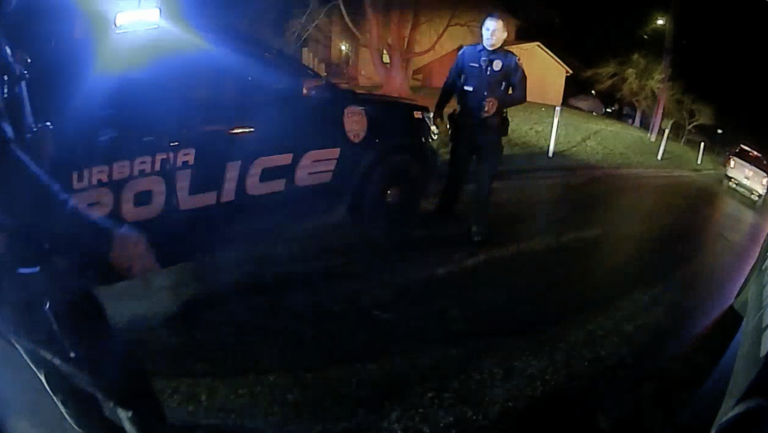This story is part of a partnership focusing on police misconduct in Champaign County between the Champaign-Urbana Civic Police Data Project of the Invisible Institute, a Chicago-based nonprofit public accountability journalism organization, and Illinois Newsroom, which provides news about Illinois & in-depth reporting on Agriculture, Education, the Environment, Health, and Politics, powered by Illinois Public Media. This investigation was supported with funding from the Data-Driven Reporting Project, which is funded by the Google News Initiative in partnership with Northwestern University | Medill.
“I had a big goose egg on my forehead,” Tianna Morrow recalled, after being pushed down by Urbana police officer John Franquemont. “I busted my head on the cart where the kids put their shoes.”
Morrow and her boyfriend, Lamar DeShawn Phillips, who are both Black residents of Urbana, were sleeping when they were woken up in the middle of the night by police in January 2018. They had crashed on the couch at an apartment rented out by Phillips’ brother. Morrow says they had his permission to be there, but police were called by the brother’s girlfriend, who was also residing in the apartment.
After he refused to leave, Officers Franquemont and Adam Marcotte, both white, moved in to arrest Phillips, and a struggle ensued. Franquemont put Phillips in a headlock, but he slipped out. Phillips attempted to escape through the front door, but Franquemont grabbed him and punched him several times in the face, according to reports by both Franquemont and Phillips.
Morrow tried to plead with the officers, but Franquemont shoved her and she fell back hitting her head on the shelf. When she got up, Marcotte pushed her and she hit her head a second time, she said in an interview with the Invisible Institute.
Phillips and Morrow were both arrested and taken to jail. They were charged with trespassing, resisting arrest and obstruction of justice.
Phillips pleaded guilty in April 2018 before unsuccessfully attempting to change his plea. Morrow’s case was delayed for almost two years, and in December 2019 was dismissed. Still upset by what happened, Morrow filed a formal complaint with the police department on March 9, 2020. “They shoved me twice,” Morrow wrote in her complaint, “and I flung back and hit my head on a cubby shoe rack.”
Creating a “moral authority”
Urbana is the smaller of the twin cities which, along with Champaign, are home to the flagship campus of the University of Illinois, one of the largest universities in the country. A Midwest college town around two hours south of Chicago by car, Urbana-Champaign has a significant Black population, for east central Illinois: around 17% in Urbana and 18% in Champaign.
The area has a long history of community activism around issues of policing dating to the 1960s. In 2009, five years before Michael Brown was killed in Ferguson, Kiwane Carrington, an unarmed Black 15-year-old, was killed by a white Champaign police officer, leading to large protests and several measures intended to clean up that city’s department.
Even earlier, in 2007, Urbana formed its Civilian Police Review Board (CPRB) in response to community members who advocated for independent oversight of the police. “The primary purpose is to bolster the public’s confidence in the police force,” Esther Patt, a longtime Urbana resident and activist, said in a 2007 city council meeting in support of creating the board.
Some community members were supportive of the board, but wary of compromises that had been made to get there. “The review board must prove itself to be a fair arbiter of complaints, without prejudice for or against the police,” activist Ricky Baldwin, a member of the mayoral task force that proposed the CPRB, wrote in the independent newspaper the Public i that September.
“Its power is in the ability to give a possibly wronged individual fair hearing and issue an independent assessment of police actions and policies. It is a largely moral authority, tied to its credibility in the community and in City Hall. And as such, its effectiveness depends wholly on its fairness as much as on its access to all the evidence.
Now for the hard part.”
Franquemont’s use of force continues: “I had a knot on my head”
In the years following Morrow’s 2018 arrest, Franquemont, who was hired in September 2015, continued to use force during several other arrests.
In December 2018, while responding to a complaint of a fight during a house party a block east of the university campus, Franquemont kneed a resident of the house in the stomach and pushed him to the ground after the resident became upset that he was receiving a noise citation and tried to walk away from officers. Inin June 2019, he repeatedly closed the door of his squad car on the knees of an arrestee who claimed his legs were bruised and couldn’t place them in the car, and could be heard mocking him on his bodycam. In January 2020, he shoved a detainee who was inquiring why he was being arrested into his squad car. The man later told investigators his head was “slammed” into the bars in the backseat of the car.
Then, in April 2020 — a month after Morrow filed her complaint — Franquemont arrested another Black woman named Laquesha Thadison. Thadison, who, according to police reports, had not listened to officers’ orders to stay away from her cousin who they were arresting, was “grabbed” by three officers, she said in an interview with the Invisible Institute, including Franquemont.
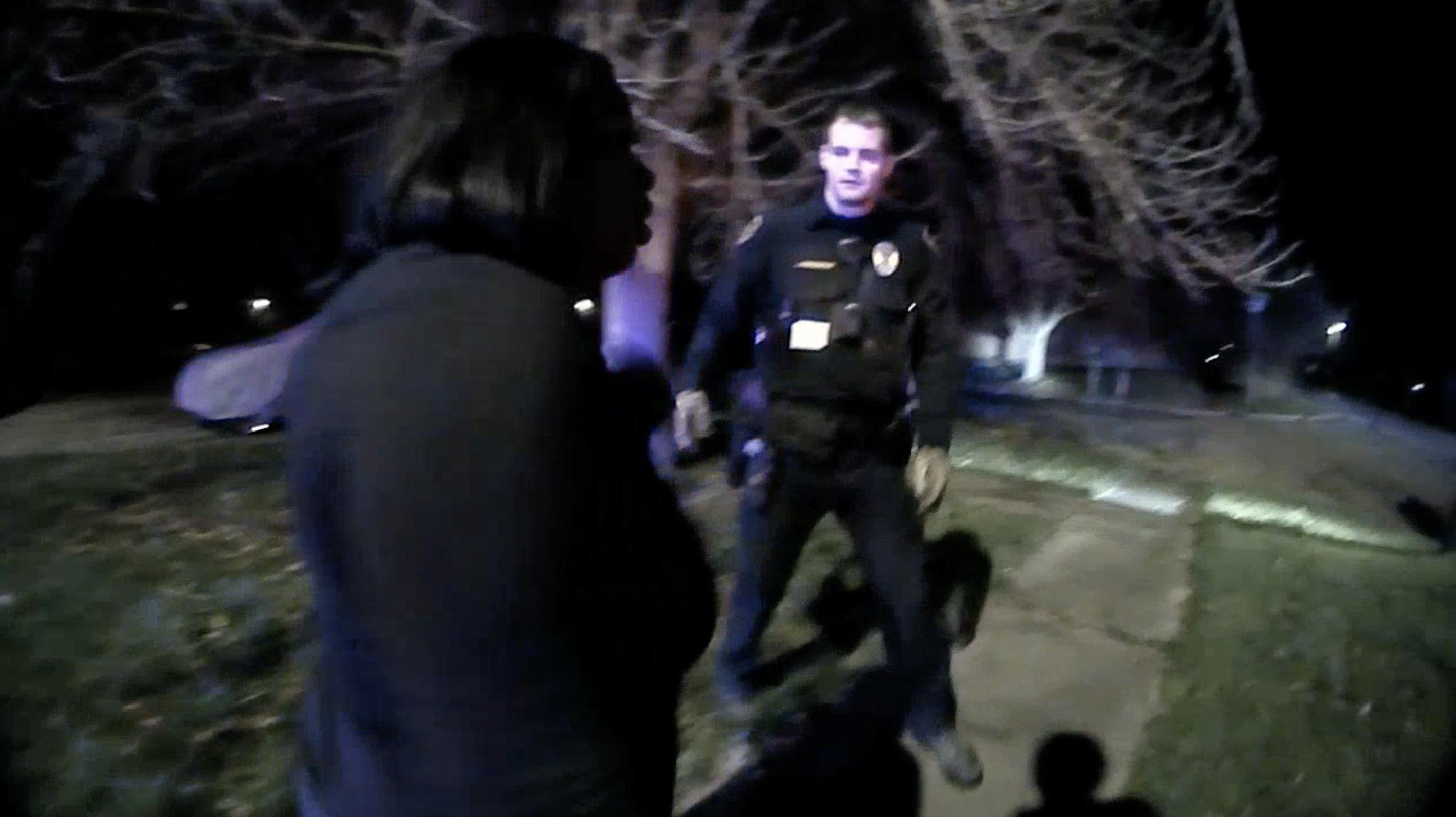
“He said that I was resisting him, but I wasn’t resisting him,” she said. “As soon as he grabbed me, he just pulled my arm behind my back, and he was twisting it real hard. I’m like, ‘Ouch, you’re hurting me. Why are you grabbing at me like that?’ And then he swung me in the car… and then he punched me in my face like, two times. My face was swollen on my county picture. I had a knot on my head.”
According to Franquemont’s own report, he “pushed Laquesha’s head onto the hood of the car and held her down until she stopped thrashing.” His bodycam was apparently knocked off in the process, so what transpired was not captured on camera. However, police were later able to watch dashcam video from the squad car.
A complaint was filed with Urbana police by Thadison the day after the incident. She described being “physically battered” by Franquemont, identifying him by name and badge number. She writes, “I did not resist. I gave him no reason to be physical.”
George Floyd changes everything
Despite the intention of the activists who fought to create it, Urbana’s Civilian Police Review Board heard neither Tianna Morrow nor Laquesha Thadison’s complaints. It was set up not to review every investigation of a citizen complaint, like many civilian oversight bodies, but only those cases where the citizen takes the extra step to appeal the determination of the internal investigation by the Urbana Police Department (UPD) to the board. As such, the board has heard vanishingly few cases over its decade-plus in existence — in fact, it didn’t hear any cases for the first four years after it was established. Between then and 2019, just two other appeals were heard.
Because Morrow waited until after her criminal case had been thrown out to file her complaint, the UPD summarily dismissed it without investigation in March 2020, weeks after it was submitted, because it had not been filed within 45 business days of the date of the incident she was complaining about. This time limit isn’t something that stems from state law, but rather city ordinance. She did not appeal this decision.
Thadison’s complaint was dismissed a month later for a similar reason: because a lawyer had contacted the city claiming to represent her, but never even told the city what the case was. Still, the UPD wrote in its letter closing the complaint, “we assume it is in connection with the criminal matter or to advise that you are considering filing or will be filing a civil action against the City.”
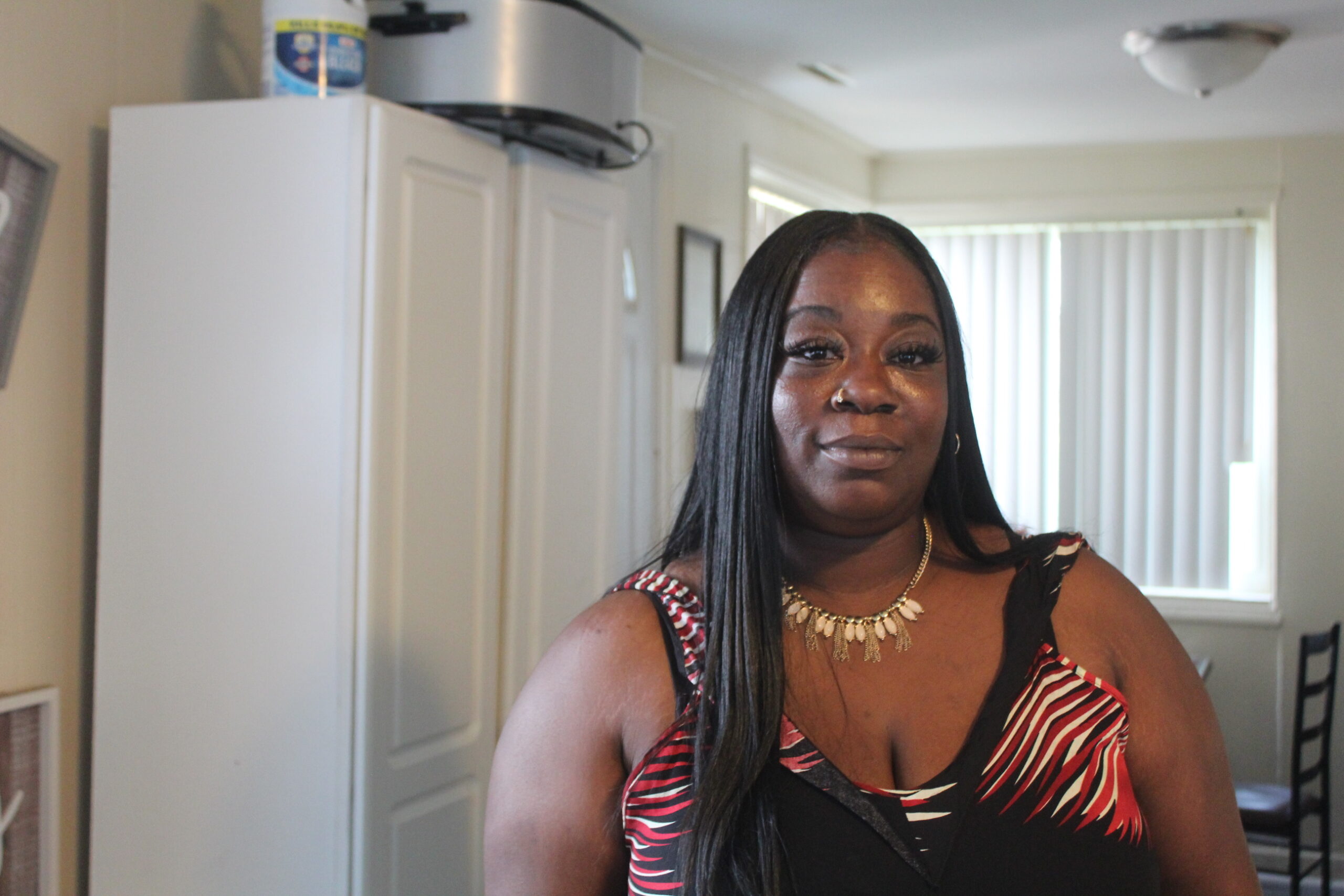
No civil lawsuit was ever filed, and the attorney, Jamie Propps, did not respond to a request for comment. The UPD did leave the option to reopen the case after court proceedings had completed, but there’s no record that that ever happened. Again, city ordinance provided the reasoning; no state law requires that all court proceedings must be finished before a police misconduct investigation can begin. CPRB officials referred to these as “floating” complaints that never get officially disposed of during a City Council meeting in January.
The restrictions around when a complaint can be filed, and whether it can exist at the same time as a criminal or civil case, are “red herrings” in police oversight, according to Sharon Fairley, a University of Chicago law professor who studies police oversight. “You absolutely can conduct a complaint investigation and resolve an administrative complaint, while civil [or criminal] litigation is ongoing,” she said. While timeliness is important, there may also be legitimate reasons not listed as an official exception to the 45-day rule why a complainant may wait to file until after it’s too late, she said.
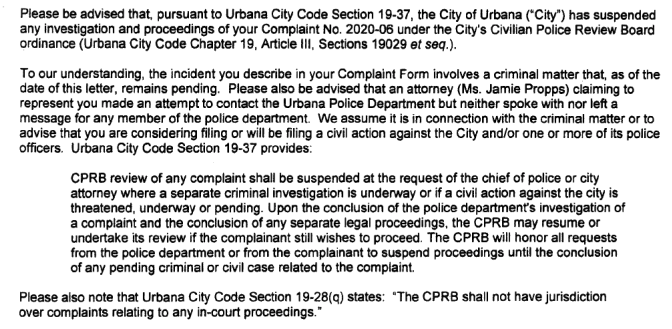
Because neither Morrow nor Thadison took that extra step to appeal their summary denials to the CPRB, “both of those things the board wouldn’t have seen,” said Mikhail Lyubansky, who chaired the board at the time, in an interview with the Invisible Institute.
As these cases were being dismissed, there was community outrage over the violent arrest of Aleyah Lewis, an unarmed Black woman, by Urbana police. Two months later, George Floyd was murdered by Minneapolis police. Over that summer, protests grew in Champaign-Urbana and nationwide over the killings and mistreatment of Black residents by white police, and many called to “defund the police.” Community members were showing up every week to speak at the meetings of the Urbana City Council, which was still convening via Zoom in the midst of the COVID-19 pandemic. Community members directed their attention on the CPRB and called for reforms.
In an attempt to build community trust, the city council approved a resolution on June 22, 2020 in support of Ten Shared Principles crafted by the Illinois NAACP and Illinois Association of Chiefs of Police. Among the principles was a belief that individuals be treated by police with “dignity and respect,” and that “de-escalation” training be required by officers. The next year, it also amended its use of force policy to align with aspects of these principles.
“George Floyd changed everything,” Lyubansky, who is a UIUC psychology professor, said. Floyd’s death “shone a spotlight on police departments everywhere.” At the time, there was “a lot” redacted from information given to the CPRB, he said, and no way to track any individual officer’s history.
Lyubansky pledged to reform the CPRB after hearing community input. “We were trying to make things more transparent,” he recalled. “We told the city that we wanted to track every single complaint, even if it didn’t go forward.” The process has been revised so that the CPRB can see a list of officers and how many complaints are against each officer.
The chair position of the CPRB has since been taken over by Ricardo Díaz, who made a presentation to the Urbana City Council on January 17, 2023 with several considerations for changes. These included many issues brought forward from the community: unredacted complaint investigations should be accessible to the CPRB, UPD records should make records available without anonymity of the officers involved, time limits for submitting complaints should be eliminated, and language in the CPRB ordinance suspending a complaint if there is civil legal action should be removed.
“We are the review [board] of appeals right now,” Díaz told the council. “We’re saying, if you want a group to be reviewing the police, then we would be it, but you have to change — whatever it takes, whenever it takes, that’s on you.”
The minor changes are still under consideration, while more significant issues — such as investigatory powers or allowing individuals with felony convictions to serve on the board — are blocked by the police union contract. After vocal concern about the lack of accountability was expressed by the public and city council members, a vote to renew the police union contract was postponed. On March 13, 2023, a 3-3 tie in votes on city council was broken by Mayor Diane Marlin to approve the contract. An opportunity to revise the police contract will not come for another three years.
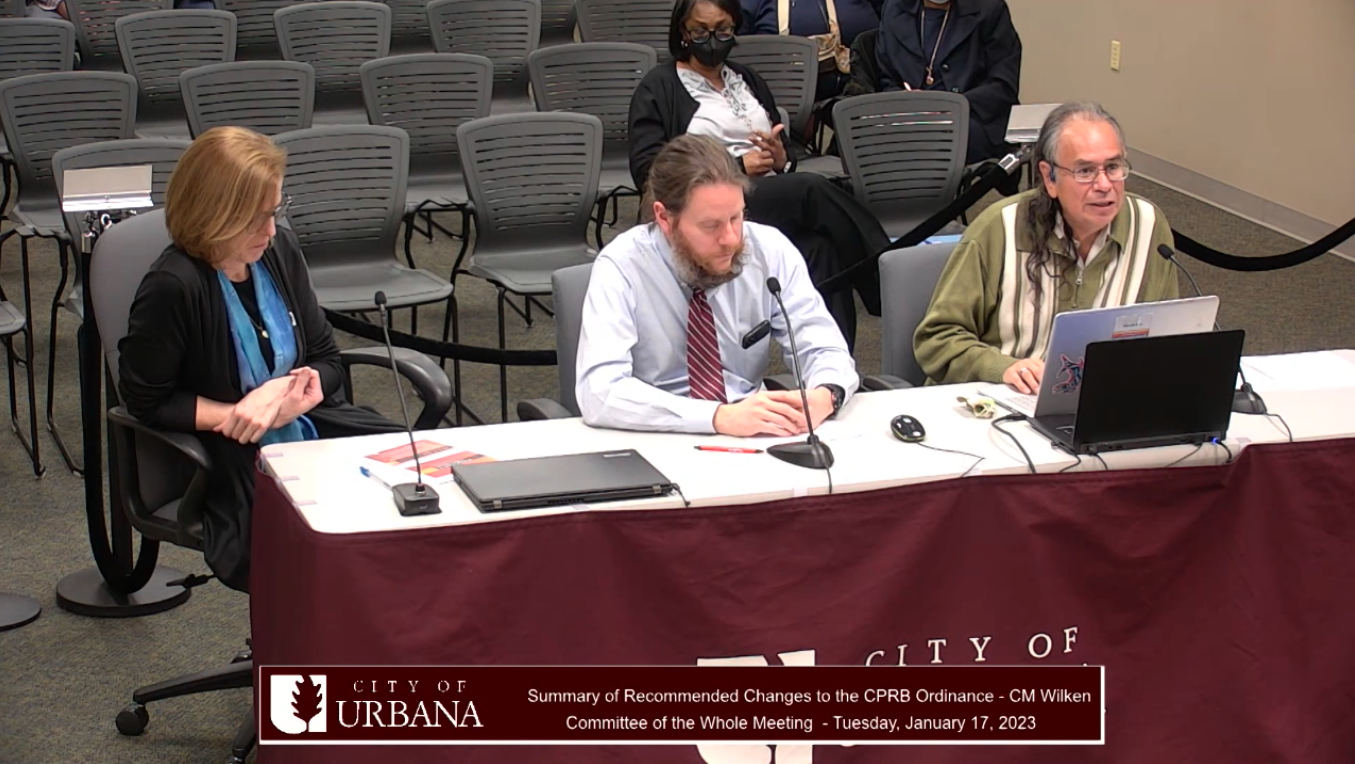
However, nothing in the contract prevents the city council from taking action to require all citizen complaints get a hearing before the CPRB, something that is relatively standard across large and medium-sized police oversight bodies, according to research by Fairley, who previously led Chicago’s Civilian Office of Police Accountability. In an interview with the Invisible Institute, she referred to appeals-only processes as “among the weakest” forms of civilian oversight.
Reporters with the Invisible Institute spent several weeks seeking comment from Urbana city officials, culminating in a detailed list of questions sent to City Administrator Carol Mitten over a week before publication — which she never acknowledged.
UPD begins moving to investigate Franquemont
Even though her official complaint to the UPD was thrown out, because Laquesha Thadison alleged at the scene of her arrest that Franquemont had punched her in the face, UPD Sgt. Jared Hurley conducted a supervisory investigation of her claims.
Hurley — who had also been on the scene with Franquemont and Marcotte during the arrest — didn’t find that Franquemont punched Thadison, but later spoke to him about how the proper way to put an arrestee into the squad car was “back side first.”
Based on Hurley’s initial findings, UPD Deputy Chief Richard Surles, currently interim police chief, then recommended that the case be reviewed by the UPD’s Use of Force Committee, an internal UPD board that met on June 17, 2020 to consider whether Franquemont abided by the department’s use of force policy. It ultimately agreed with Hurley’s conclusion that “pushing Thadison face-first into the backseat of the squad car served no legitimate purpose,” but did not find that he punched her.
During this meeting, Det. Jeff Steinberg alerted the committee to another video capturing Franquemont’s arrest of Jacob Comstock, a 35-year-old white man who was driving in east Urbana on January 20, 2020. That Monday afternoon, Franquemont was on patrol with UPD Officer Jeremy Hale. Franquemont spotted Comstock’s car, and ran his plates. He found a notice of a warrant, and pulled the car over.
Franquemont got Comstock out of the car and put him in handcuffs, before confirming the warrant. Franquemont admitted in his own report, “I told him I was unsure of what it was for.”
Comstock insisted he had no warrant, and Franquemont again responded with force. As Comstock later told investigators, when Franquemont shoved him forwards into the back of the squad car, the left side of his face was “slammed” against a metal bar. Video released by the UPD shows Franquemont suddenly shoving Comstock, who had been vocally but not physically protesting being handcuffed.
Officer Hale recounted in a later interview that after the arrest Franquemont did not intend to write a police report, as Comstock had been let go. Hale remembered telling him, “Dude, you put somebody in handcuffs. You need to write a report.” After being shown the video, Hale, who did not see the use of force on the scene, commented that “it escalated quickly.”
When the Use of Force Committee was notified of the Comstock video on June 17, the “ball began rolling,” Steinberg later told an investigator.
Franquemont was immediately put on paid administrative leave, pending a criminal investigation into the Comstock case by the Illinois State Police. Champaign County State’s Attorney Julia Rietz reviewed ISP’s investigation for criminal charges, but in November, declined to file any against Franquemont. This left it up to Urbana police to pursue any internal disciplinary action.
Breakdowns in accountability
As the investigation moved forward in these initial stages, it became clear that mechanisms in place to hold police accountable had broken down. Steinberg reviewed the Comstock video shortly after it happened as part of his regular duties, but failed to report the abuse, assuming that the Use of Force Committee would be reviewing the video anyway. A lieutenant later reminded him of the police concept of the “duty to intercede”: Steinberg had the responsibility to notify a supervisor.
It’s not clear whether this failure to review is, or was, standard practice; Steinberg was apparently told in June 2020 that “the UOF committee was not reviewing body worn camera as a typical part of their UOF review” according to a report written by Lt. David Smysor, the UPD’s then-criminal investigations commander and the supervisor of the internal Use of Force Review Committee.

However, Smysor told outside investigators looking at the city’s use of force system in a July 2020 interview that “when reviewing use of force incidents, the [Use of Force Review Committee] members routinely review” body-worn camera footage, and added that “BWCs are a great help in evaluating use of force incidents and to ascertain what happened,” according to a summary of the interview.

In addition, the internal review committee, which is charged by UPD policy with reviewing “all incidents involving uses of force” and making a finding as to whether they were within department policy, only took issue with two of Franquemont’s roughly 60 uses of force, according to data obtained by the Invisible Institute. One was for not finding all of the cannabis that an arrestee had on his person.
The other, from November 2018, was for an incident in which he “grabbed” a minor who had run away from him and was refusing to answer questions “by the back of the neck and pushed her to the ground,” according to a summary of the incident in use of force data released by UPD. For that case, the committee noted simply, “Need to talk to [Franquemont] about grabbing around the neck.”
UPD has denied Invisible Institute’s attempts to obtain more records about this case, claiming that they’re protected under the state Juvenile Court Act. Matt Topic, an attorney with Loevy & Loevy in Chicago who regularly argues public records lawsuits — including on behalf of the Invisible Institute — said the city’s reasoning is without a legal grounding. “There is no basis to withhold information about the force used against minors in the course of a police interaction once the juvenile’s name and information about the juvenile’s actions being investigated has been redacted,” he wrote in an email.
The vast majority of the rest of the uses of force, including those against Tianna Morrow and Lamar Phillips, are marked as having “no issues” identified by the committee. For nearly all of its cases, it does not produce a written report, as it did for Thadison and Lewis’s cases, but briefly relays its findings in the use of force spreadsheets that the UPD maintains.
The internal investigation process failed, too, in sometimes absurd ways. Sgt. Jared Hurley tried to get a formal statement from Thadison during his supervisory investigation on April 5, calling her house at 10:45pm and waking her up. She said she could speak the next day, and ended up agreeing to meet with Hurley on April 8.
The next day, however, she filed her handwritten citizen complaint with the UPD — likely believing this to be what Hurley needed to take the next step in his investigation. That evidently never got to Hurley, who wrote in a report on May 11 that he never heard back from her. By that time, UPD had already informed Thadison that it wouldn’t be pursuing her complaint, simply because a lawyer claiming to represent her had contacted the city.
Even relatively extraordinary measures for an internal investigation brought perplexing results. The UPD hired an outside consultant — Michael Schlosser, the former director of the UIUC Police Training Institute — to give his opinion on Franquemont’s use of force in the Comstock case. In Schlosser’s review, dated October 12, 2020, he found the use of force was “reasonable.” He did recommend, however, that Franquemont receive additional training in de-escalation techniques and control tactics. He was paid $2,250 for the report, according to city records.
After Franquemont was put on leave, Urbana police launched its formal investigation into possible excessive use of force, led by Lt. Smysor. Investigators began a review of his interactions with the public over the previous 12 months. This included 198 videos, 97 citizen contacts, 14 traffic stops, and 87 use of force/arrest incidents. They flagged a handful of incidents, including the Comstock and Thadison cases, which Smysor wrote “fit the pattern of problematic conduct that has been described.”
In one of those incidents, Franquemont arrested Michael Arvola for trespassing on June 15, 2019, at the Schnucks grocery store in Urbana. Arvola was a 55-year-old white man known to police as having a history of mental health issues. He was escorted out to the squad car and sat down in the back seat. Arvola complained that his leg hurt and his thigh was bruised, making it difficult for him to lift his legs into the car. He also disputed whether he had been banned from the store.
Franquemont then quickly shut the door on Arvola’s legs without warning. Franquemont told him to get inside the car. Arvola responded, “Or?” Franquemont abruptly slammed the door on his leg a second time. Franquemont repeated his request. “Or what?” Arvola said again. Franquemont shut the door on his leg a third time and said, “Or I bruise your knee again, dumbass.”
This case was not logged by Franquemont as a use of force; it’s not clear that it ever would have been looked at by the Use of Force Committee, even if it had been reviewing video footage.
Lt. Smysor began to interview several Urbana police officers about the five incidents, compiled his findings, and eventually confronted Franquemont in an interview.
Franquemont unrepentant
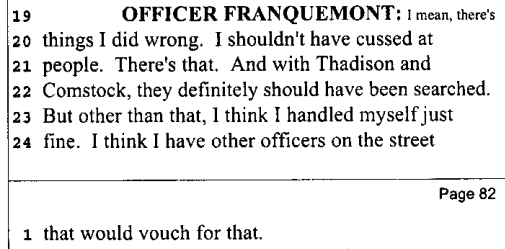
The interrogation of Officer Franquemont took place on February 26, 2021. Deputy Chief Richard Surles and Lt. David Smysor were present with the city attorney Ben Gehrt, and Officer John Franquemont was there with his attorney Ron Langacker, and FOP lawyer Rob Scott, in accordance with his rights under the collective bargaining agreement between the city and the Fraternal Order of Police (FOP).
Smysor led much of the questioning throughout the two-hour long interview, proceeding through each of the five incidents. It ended with a heated exchange between Smysor and Franquemont over the Arvola case. Why was there no mention in the written report, Smysor asked, about slamming the door on Arvola’s leg? “I didn’t think it was that big of a deal,” Franquemont responded. “Calling him a dumb ass,” Franquemont did admit, “was something I shouldn’t have done.”
“Do you agree uncooperative subjects do not deserve corporal punishment for their obstruction?” Smysor finally charged. At this point, Scott, the FOP attorney interrupted and told Franquemont to say, “No.” Smysor asked, “You don’t feel like you ever crossed the line?” to which Franquemont replied, “No.”
“I mean, there’s things I did wrong. I shouldn’t have cussed at people,” Franquemont concluded. “But other than that, I think I handled myself just fine. I think I have other officers on the street that would vouch for that.”
On May 3, 2021, Smysor completed his investigation and turned it over to Urbana Police Chief Bryant Seraphin. On November 10, Chief Seraphin sent a letter to Franquemont requesting a meeting before he made any final decision. Franquemont scheduled a meeting, but then decided not to appear, and instead sent a letter defending himself against the allegations.
A notice of termination was sent to Franquemont on March 2, 2022. “I am disappointed and troubled,” Seraphin wrote, “that after reviewing the videos and situations against the backdrop and policies and practices that you do not recognize your shortcomings and acknowledge the inappropriate, unnecessary, and excessive uses of force and related policy violations in these incidents. Your unwillingness to accept culpability leaves me no hope you can learn from these incidents and reform your behavior.” Franquemont’s employment with the City of Urbana was terminated on March 11, 2022.
However, Franquemont has further protections he can take advantage of. He has appealed his termination to a third-party arbitrator, a process available to him through the city’s Fraternal Order of Police union contract. Urbana’s contract provides that the arbitrator’s decision is final and binding on all parties; unlike some other departments, it cannot be appealed to the court system.
There haven’t been any Urbana arbitration decisions in recent years, but notorious former Champaign officer Matt Rush, who was the subject of multiple excessive force lawsuits and whose pattern of force was known to city leaders for years, was twice reinstated by arbitrators before finally being removed from the force in 2017. In general, arbitrators overturn over half of police disciplinary cases that they hear, according to a 2021 article by a Loyola University Chicago law professor.
“I want the message to be sent: this man, he don’t need no job back at the Urbana Police Department,” Thadison told the Invisible Institute in an interview. “To me, he’s like Officer Rush from Champaign.” Franquemont’s attorneys did not respond to a request for comment.
Urbana’s use of force reforms
Could the Urbana Police department have been put on notice about Franquemont earlier, and prevented excessive force from being used on Morrow, Thadison, Comstock, and others?
After he joined the UPD in 2016, Franquemont used force an average of about 12 times a year through 2020. In 2017, for example, he wrote, that he “wrapped my right arm around the back of [an arrestee’s] neck, put my right foot in front of his left foot, turned my body to the left, and forced his body to the ground using my body weight,” while the man was in handcuffs inside of his house. Franquemont took care to note in his report that he “did not stop [the man] from breathing”; by contrast, the man said he had asthma and could not breathe, and had to be taken to a hospital.
The Use of Force Committee found “no issues” with the use of force, which potentially violated the UPD’s Use of Force policy. At the time, the policy prohibited applying “direct pressure to the throat, windpipe or airway of a person with the intent to reduce or prevent the intake of air (chokehold) unless deadly force is justified.”
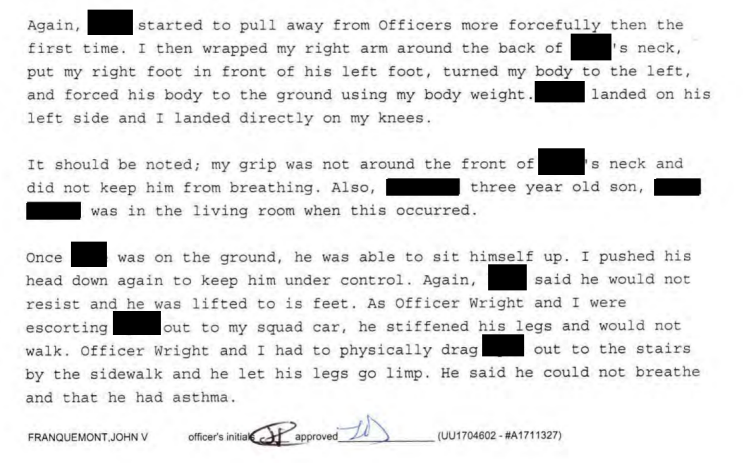
UPD could have been put on notice by Morrow herself. The agency did not equip its officers with body cameras until 2019 — two years after Champaign — so most if not all of Franquemont’s uses of force before then would not have camera footage. Still, Morrow told booking staff at the Champaign County Jail that she had been beaten by Franquemont as Officer Marcotte brought her to the jail, and Marcotte wrote that he noticed a “knot” on Morrow’s forehead.
Morrow’s claims, and when during the process she made them, are almost identical to Thadison’s, which two years later prompted a supervisory investigation that led to Franquemont’s termination. Why didn’t Morrow’s?
Some reforms have been undertaken by the city since it learned about Franquemont. In the aftermath of the protests against the murder of George Floyd and use of force against Aleyah Lewis, the city administration hired a private firm to evaluate the UPD’s use of force system. The firm’s review, dated September 3, 2020, found that UPD’s policies were severely lacking in both the rules governing use of force, and its ensuing investigations.
Some of the 18 recommendations that it made to the city, which included better training for supervisors investigating uses of force, were since implemented. However, no policy changes have occurred that require the board to create documentation for each review, to justify its determinations that nearly every single use of force by Urbana Police officers is justified.
Indeed, in response to recent Invisible Institute records requests, the city has only been able to produce two reports that the committee has written, for the Lewis and Thadison cases. In response to a records request, the city told the Invisible Institute that the only documentation of other determinations by the board — even in cases where they note training or other deficiencies — lies within use of force databases that the city maintains, including for cases after the city received the recommendations.
This continues to today. The department’s 2022 Use of Force analysis report, released to the City Council in late May, shows that of the 95 uses of force last year, 86 were found within policy by the review committee, which now includes a civilian: former longtime CPRB member Scott Dossett. In nine, “tactical training action” was taken. No officers were disciplined. No reports of the review committee were created.
New leadership
“I’m glad he was fired,” Thadison said. “He’s been abusing his authority… he was not in control of his emotions. He was more intimidating than reassuring that he’s here to help you.”
Whether the department will catch future patterns like Franquemont’s earlier, or prevent officers like Franquemont from being hired in the first place, is another matter.
After the retirement of controversial Chief Bryant Seraphin in March 2022, Urbana launched a search for a new police chief. This April, Mayor Diane Marlin announced that Larry Boone emerged as the sole finalist. Boone, who is Black, is the former police chief in Norfolk, Virginia who made national news by marching with Black Lives Matter protesters after George Floyd’s murder.
Urbana’s history of advocating for police reform provides Boone an opportunity for a more progressive approach to policing. What change he brings with him, and what the city’s political establishment will allow him to do, remains to be seen.
Additional reporting by Sam Stecklow and Andrew Fan of the Invisible Institute
Brian Dolinar has reported on criminal justice issues in Champaign-Urbana for almost 20 years. Working as a freelance journalist, his articles have appeared at The Appeal, Chicago Reader, In These Times, Prison Legal News, and Truthout. He worked with the Invisible Institute to produce this report on the misconduct of Urbana police officer John Franquemont.

